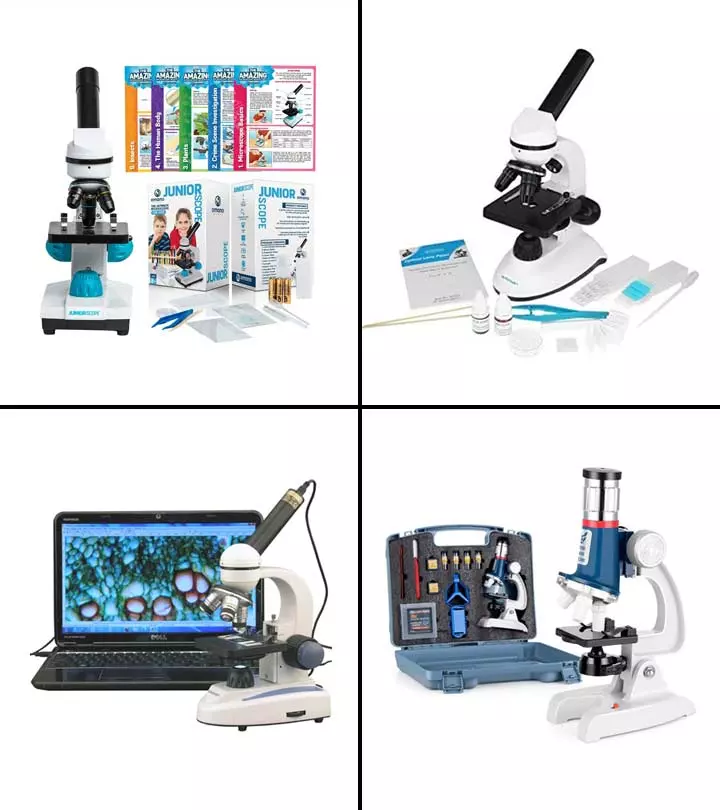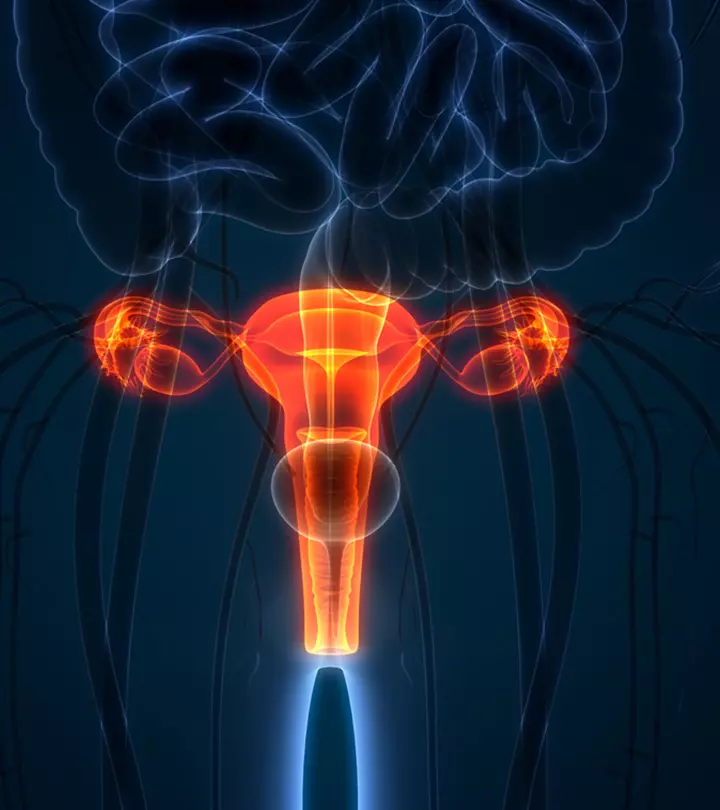

Image: Shutterstock
Water breakage during pregnancy is crucial in the third trimester since it signals labor. The amniotic fluid surrounds the baby in the amniotic sac. This sac breaks at the beginning of labor. If you notice the flow of fluid, contact a healthcare professional. Some pregnant women may misinterpret urination (due to the womb’s pressure on the urinary bladder) as water breaks. However, before rushing into the maternity center, ensure it’s not urine.
Water breaking significantly earlier than the due date can be concerning. Read on to know the causes of water breaking in pregnancy, how to distinguish it from urination, and when to go to the hospital.
What Is Water Break During Pregnancy?
The fetus is surrounded by a membranous fluid-filled sac inside the womb known as an amniotic sac. The sac protects and cushions the baby throughout your pregnancy. When this amniotic sac ruptures, the fluid passes through the cervix and vagina. The rupturing of the membrane is accompanied by the release of certain hormones and chemicals that begin the contractions, signaling the start of labor (1). This fluid is constantly swallowed, inhaled, and expelled by the baby. Moreover, the fluid helps:
- The fetus moves freely inside the womb.
- Maintain a constant temperature around the fetus.
- Proper development of lungs
At around the right time, it makes your body ready to push the baby into this world. However, water breaking doesn’t always indicate labor because, sometimes, it could happen prematurely.
What Does It Feel Like When Your Water Breaks?
You may feel a popping sensation, or it can trickle when the water breaks during pregnancy. This is followed by a gush of fluid that cannot be stopped by squeezing the pelvic muscles. However, some women may not experience the sensation of water breaking, and they may know it from the leaking fluid. A few women explain the feeling of water breaking as bladder relief with a warm sensation (2).
What Causes Water Break During Pregnancy?
Here are the reasons why water break happens during pregnancy:
- As you reach full term during pregnancy, the amniotic sac spontaneously ruptures, and you enter labor. This causes a trickle, a slow leak, or a gush of fluid through the vagina (3).
- If the water breaks before full-term, but after 37 weeks, it is called premature rupture of membranes (PROM). Most women go into labor within 24 hours of the water break. This may happen due to:
- Infection of the vagina, uterus, or the cervix
- Extensive stretching of the amniotic sac (due to too much fluid or carrying multiple babies)
- Surgery or biopsies of the cervix
- A history of PROM or PPROM (preterm premature rupture of membrane) (4)
- If a woman experiences a water break before 37 weeks of pregnancy, it is called preterm premature rupture of the membrane (PPROM). This condition occurs in around three percent of pregnancies and is the reason for one-third of preterm births. The chances of PPROM are high in women (5):
- Belonging to the lower socioeconomic status
- Who smoke
- Having a history of sexually transmitted infections
- With a previous preterm delivery
- Who have vaginal bleeding or uterine distension
The doctor will arrange for your delivery if your water breaks or PPROM happens between 34 and 37 weeks.
However, if the water breaks before 34 weeks, the doctor will postpone the labor by recommending bed rest. You would be prescribed antibiotics to avoid infections and corticosteroids for the baby’s lungs to grow. Labor will be induced when the baby’s lungs grow enough (4).
Once the water breaks, your baby is no longer protected by the amniotic fluid. But your body continues to produce the fluid to facilitate delivery.
What Are The Signs Of Water Breaking During Pregnancy?
Here is how you can check what’s happening with you:
- If you notice a sudden gush of fluid wetting your pants, it could be the amniotic fluid. You may confirm it through the following steps (3):
- Make your bladder empty.
- Collect some leaking fluid on a maternity pad. If it has a stench and is yellow, it could be urine. If it is colorless and odorless, it could be amniotic fluid.
- Hold your pelvic floor muscle tight (like in a Kegel exercise) to control the flow. If the flow stops, it is urine; if it continues to leak, it means water has broken.
- Ascertain the time, color, and odor of the discharge.
- Water break is usually accompanied by spotting or some flow of blood.
- You might have a fever or a rise in your body temperature after the water breaks.
- Check for your baby’s movements when you experience excessive fluid flow.
Once you confirm the leak is a water break, do not panic. Instead, call your doctor and take some precautions to hold it until some help arrives.
How Does The Doctor Check Your Water Breaking?
The doctor can confirm water breaks using two methods. They are:
- Placing a speculum into the vagina to check for water pools. The doctor may also collect the swab samples and get them tested for infection.
- In the amnicator test, the doctor soaks the swab sample in pH-detecting dye nitrazine yellow. In the presence of amniotic fluid, the nitrazine color changes from yellow to blue-yellow or dark blue, confirming the water break (6).
If the above tests do not work out, you should wait for more fluid flow.
What Precautions To Take After Water Breaks During Pregnancy?
Here are some measures you may take when water leaks:
- Call up the hospital or the doctor. Inform them of the situation and follow their instructions.
- The water break exposes your baby to infections that travel upward from the vagina. If the doctor thinks that you should wait for up to 12 hours, they will tell you what to do to protect yourself and your baby from infections. Keep the vaginal area clean and take the other required precautions.
- If you are at home or traveling to the hospital, place a plastic cover on the bed or the car seat to prevent it from getting wet.
- Wear a maternity pad if the flow is slow, or use a towel if it is gushing. This helps you keep your clothes clean. A maternity pad also helps you to collect the sample and show it to the doctor because the flow could contain something more than just the amniotic fluid:
- If the fluid is brown or green, it may indicate that the baby has had its first bowel movement (meconium) inside the womb (7). As your baby breathes that amniotic fluid, the meconium might go into their lungs causing breathing trouble. Collect it on a maternity pad for the doctor to examine. Consult your doctor on what to do next.
- Sometimes, the umbilical cord drops into the cervix or even the vagina (umbilical cord prolapse) with the gushing amniotic fluid. This happens when the membrane ruptures and the baby has not reached the pelvis. Prolapse occurs in one out of 300 deliveries. If you notice a loop of the cord at the vaginal opening, seek immediate medical attention (8).
Water break is usual, but you may not immediately know what to do when the water is gushing out. Seek help from your partner, mother, or somebody with you. Ask them to contact the hospital immediately. Most importantly, do not panic, as it could distress your baby and complicate the labor.
During this time, you will be flooded with several questions. Below, we answer a few such questions to keep you prepared for the event.
Frequently Asked Questions
1. What if the water doesn’t break on its own?
With the onset of labor, the cervix dilates, and the baby’s head drops into the pelvis. If the waters do not break by this time, the doctors use a technique called amniotomy (also termed artificial rupture of membrane) (1). In this technique, a small hole is made in the amniotic sac using a thin plastic hook to leak the water. This helps start the labor contractions or intensify them if they have already begun.
2. What happens if the water breaks with no signs of contractions?
The contractions might usually start 12 to 24 hours after the water break. Even if they don’t, the consultant might ask you to wait if you do not have any related complications. If the labor does not start after 48 hours, it will be induced through medical interventions (9).
3. How to know if it is a water break or vaginal discharge?
Amniotic fluid is colorless and odorless, whereas the vaginal discharge is thin, milky white mucus. If you notice a mucus-like discharge streaked brown or pink with blood, it might indicate that labor is near (10).
4. Will my water break before I go into labor?
It is possible to have a water break before going into labor. Some women may begin labor within 24 hours of water break. Usually, delivery is induced after the water breaks if the baby is ready to be delivered (2)
5. Is it pee or water break?
Water break can be associated with a popping sensation. However, it cannot be easy to differentiate amniotic fluid from urine if you only have the feeling of wetness.
6. How much water comes out when your water breaks?
The amount of fluid coming out can vary in each woman after the water breaks. While 600mL of fluid is present near the due date, around 800mL in 34 weeks of pregnancy. Most women will go into natural or induced labor and delivery before the fluid dries off (11).
The colorless and odorless nature of the amniotic fluid distinguishes it from leaking urine towards the end of pregnancy. Usually, labor starts within 24 hours following the water breakage during pregnancy. Water breakage before 37 weeks may also be caused due to infections, overstretching of the amniotic sac, or a history of preterm premature rupture of membrane (PPROM). Therefore, seek immediate medical attention if you feel your water has broken. You may also collect some of it in a maternity pad to help doctors examine it.
Key Pointers
- Odor and color can help distinguish between urine and amniotic fluid.
- Labor is induced to prevent the risk of infections if the baby is ready to be delivered.
- Labor is delayed for fetal lung maturation if the water breaks before 34 weeks.
References
- Amniotomy for shortening spontaneous labour.
https://www.cochrane.org/CD006167/PREG_amniotomy-for-shortening-spontaneous-labour - What to expect when your waters break.
https://www.tommys.org/pregnancy-information/giving-birth/what-expect-when-your-waters-break - Amniotic Fluid.
https://www.sutterhealth.org/health/labor-delivery/amniotic-fluid - Premature rupture of membranes.
https://medlineplus.gov/ency/patientinstructions/000512.htm - Shailja Dayal and Peter L. Hong; (2021); Premature Rupture Of Membranes.
https://www.ncbi.nlm.nih.gov/books/NBK532888/ - Amnicator
https://pluspunt.mediqmedeco.nl/fileuploader/download/download/?d=0&file=custom%2Fupload%2FFile-1419862297.pdf - Meconium Aspiration Syndrome (MAS).
https://kidshealth.org/en/parents/meconium.html - Umbilical Cord Prolapse.
https://my.clevelandclinic.org/health/diseases/12345-umbilical-cord-prolapse - Labor Induction.
https://www.acog.org/womens-health/faqs/labor-induction?utm_source=redirect&utm_medium=web&utm_campaign=otn - Am I in labor?
https://medlineplus.gov/ency/patientinstructions/000508.htm - Amniotic Fluid.
https://medlineplus.gov/ency/article/002220.htm
Community Experiences
Join the conversation and become a part of our nurturing community! Share your stories, experiences, and insights to connect with fellow parents.
Read full bio of Dr. Stuart J. Fischbein
Read full bio of Dr Bisny T. Joseph















